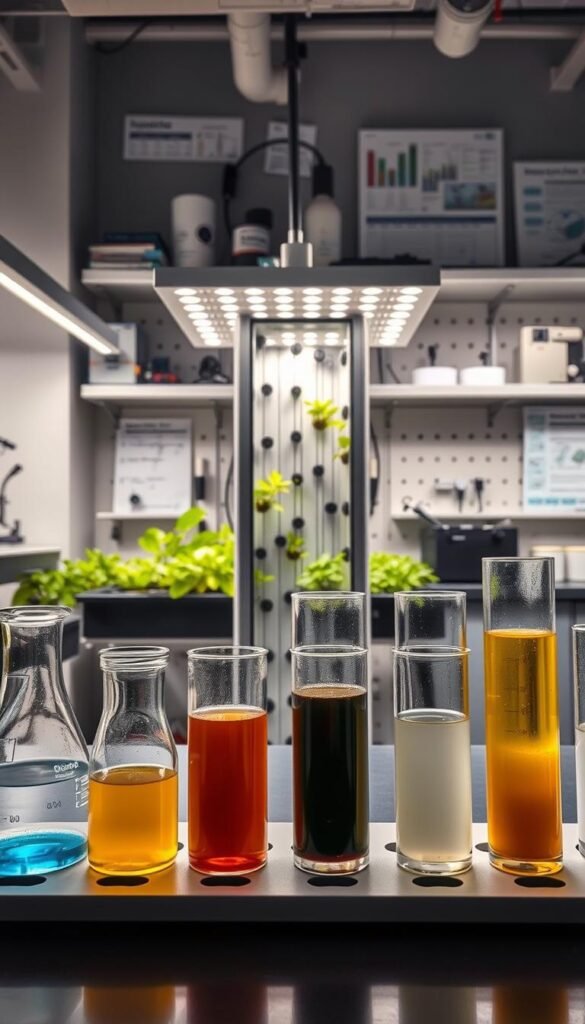Growing plants without soil might sound like magic, but it’s all about what you feed them. In hydroponic systems, plants get their meals through carefully crafted liquid formulas. These mixes replace traditional dirt gardening by delivering exactly what roots need to thrive.
Think of these liquid formulas as a plant’s daily multivitamin. They contain nitrogen, phosphorus, and potassium – the big three nutrients – plus other essentials like calcium and magnesium. The right balance can mean the difference between wilted leaves and bumper crops.
Farmers and home growers use two main approaches: pre-made fertilizer programs or custom recipes. Complete formulas like Modified Sonneveld’s solution have stood the test of time, while newer blends keep pushing boundaries. Getting the concentration right matters just as much as the ingredients themselves.
Key Takeaways
- Liquid formulas provide essential minerals directly to plant roots
- Different mixes work better for specific plants or growth stages
- Pre-made programs simplify feeding schedules
- Custom recipes allow precise control over nutrients
- Balance between strength and quantity affects results
- Established formulas offer proven performance
Introduction to Hydroponics and Nutrient Solutions
Plants don’t need dirt to flourish—they just need the right fuel delivered straight to their roots. Imagine giving your greens a VIP pass to every mineral they crave, without the guesswork of traditional gardening. That’s the power of modern hydroponic systems.
What Are Nutrient Solutions?
These liquid formulas act like a personalized meal plan for your plants. Instead of digging through soil for minerals, roots soak up a precise blend of nitrogen, potassium, and other essentials mixed into water. You control exactly what—and how much—your crops consume.
Most setups use pumps or wicking materials to keep the mixture flowing. This constant access lets plants focus energy on growing leaves and fruits rather than expanding root networks. Even herbs like basil grow 30% faster this way, according to urban farming trials.
Benefits of Hydroponic Gardening
You’ll save up to 90% more water compared to soil gardening since the system recycles every drop. No weeds. No pests hiding in dirt. Just adjust the formula as your tomatoes transition from seedlings to fruit-bearing vines.
Beginners love how easy it is to spot issues. Yellow leaves? Maybe the mix needs more iron. Stunted growth? Check the pH balance. With direct nutrient access, you become both scientist and chef for your plants’ perfect diet.
Understanding Nutrient Solutions for Hydroponic Systems
Your plants’ success starts with what’s in their water. These liquid formulas act like a personalized toolkit, delivering 17 essential elements through their roots. Getting the mix right means balancing big-dose minerals with tiny-but-crucial trace components.
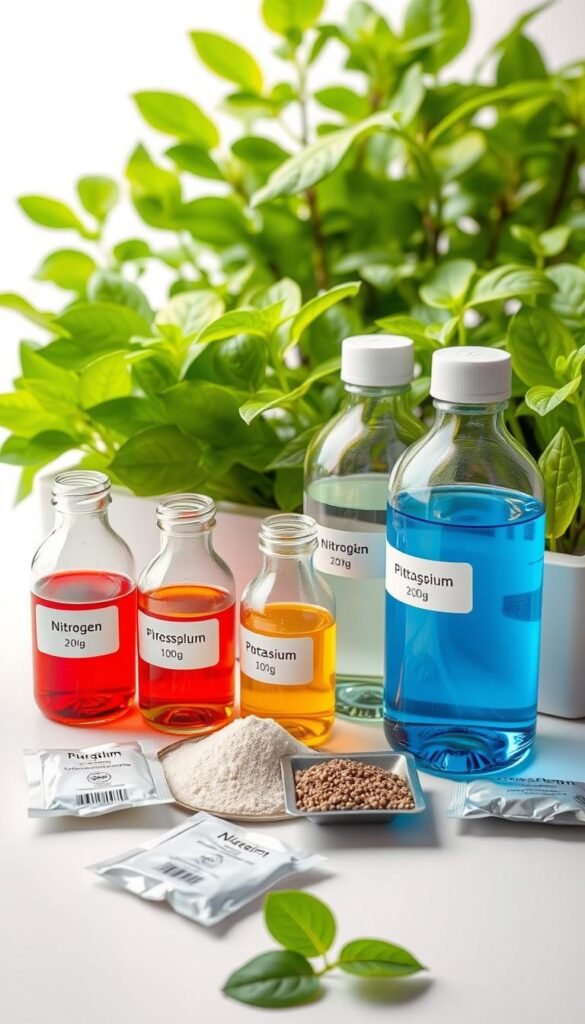
Key Components and Their Roles
Macronutrients form the foundation of any solution. Nitrogen fuels leafy growth, while phosphorus strengthens roots and flowers. Potassium acts as the plant’s wellness coach, regulating water flow and disease resistance. Calcium keeps cell walls sturdy—without it, tomatoes develop blossom-end rot even in water systems.
Micronutrients work behind the scenes in smaller amounts. Iron helps produce chlorophyll, and zinc activates growth hormones. A University of Arizona study found adding just 0.5 ppm of manganese boosted lettuce yields by 18% in raft systems.
Watch for these signs of imbalance:
- Purple-tinged leaves signal phosphorus shortage
- Curling leaf edges often mean calcium deficiency
- Yellow veins indicate lacking iron
Commercial growers often use three-part formulas to adjust ratios during growth stages. A basil farm in Colorado switches from high-nitrogen blends for seedlings to potassium-rich mixes before harvest. You’ll achieve similar precision by testing your solution weekly and adjusting concentrations as needed.
Comparing Nutrient Solutions for Hydroponic Growth
Choosing the right liquid formula can make or break your water-based garden. Different blends work better with specific setups—what thrives in a drip system might clog aeroponic misters. Your water’s hardness plays a bigger role than you’d think, affecting how minerals dissolve and interact.
Pre-made blends offer convenience but limit customization. They’re great for beginners or small-scale systems where simplicity matters. Custom mixes let you tweak ratios for flowering plants versus leafy greens, though they demand precise measurements and regular testing.
Watch out for chalky residues in your reservoir—these signal solubility issues. Concentrated formulas sometimes form crystals that block irrigation lines. A Florida tomato farm solved this by diluting their stock solution and adding citric acid to stabilize the mix.
Your system’s design directly impacts nutrient effectiveness. Deep water culture setups need stronger oxygenation to prevent root rot, while NFT systems require faster-flowing formulas. Always test your water source first—high chlorine or sodium levels can throw off delicate balances.
Quick tips for success:
- Match solution strength to your plants’ growth phase
- Use filtration if your water contains sediments
- Record pH changes after adding each component
Fertilizer Programs and Their Role in Nutrient Solutions
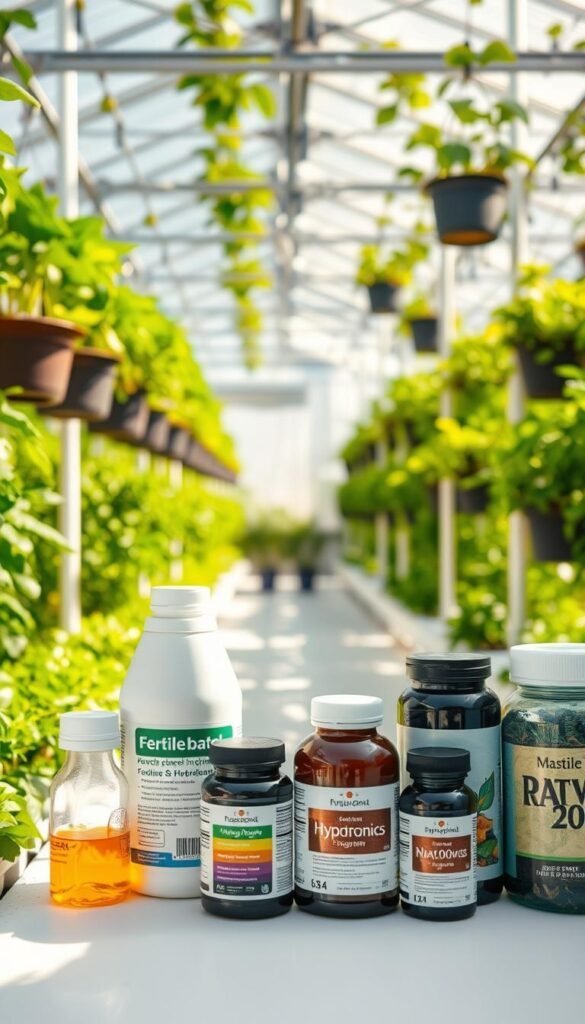
Imagine having a personal chef for your plants—someone who prepares balanced meals without requiring your input. That’s essentially what commercial fertilizer programs offer. These pre-designed blends handle the heavy lifting of nutrient delivery, letting you focus on monitoring plant health rather than mixing chemicals.
Benefits of Fertilizer Programs
Brands like Hydro-Gardens Chem-Gro turn complex science into simple routines. Their tomato-specific program, for instance, provides measured packets for each growth phase. “Just add water and follow the schedule,” their guidelines promise. You’ll spend less time calculating ratios and more time watching your crops thrive.
These systems shine in consistency. A lettuce farm in Ohio reported 22% higher yields after switching to a pre-mixed program. No more guessing if you added enough magnesium or dialed back phosphorus. Everything comes pre-portioned, reducing errors and storage hassles.
Limitations and Considerations
But what if your water already contains calcium or sulfates? Pre-made blends can’t adjust for existing minerals in your supply. A pepper grower in Arizona discovered their well water’s high iron levels clashed with their chosen formula, requiring extra filtration.
Customization is another hurdle. Want to boost potassium during fruiting? You’ll need separate additives, which complicates the simplicity these programs offer. Always test your water source first and compare its profile against your fertilizer’s ingredients.
Quick tip: Use pre-mixed programs for time-strapped growers or single-crop setups. Opt for customizable options if you’re juggling multiple plants or dealing with unique water chemistry.
Nutrient Solution Recipes Explained
Crafting the perfect plant food mix combines kitchen precision with lab-grade accuracy. Whether you follow established formulas or create custom blends, understanding ratios separates thriving crops from struggling ones. Let’s crack open the recipe book for water-based gardening.
Modified Sonneveld’s Solution Recipe
This trusted formula delivers balanced nutrition for tomatoes and cucumbers. Mix 14.4 grams of calcium nitrate and 6.6 grams of magnesium sulfate per gallon. Add micronutrients: 1.3 grams iron chelate, 0.02 grams copper sulfate, and 0.05 grams boric acid.
Target ppm values:
- Nitrogen: 200 ppm
- Potassium: 350 ppm
- Calcium: 180 ppm
Adjust amounts based on your water volume. A 10-gallon system needs 10x these measurements. Always dissolve powders separately before combining to prevent chemical reactions.
Mastering the Calculations
Precision scales become your best friend. For 5 gallons needing 150 ppm potassium, multiply desired concentration by liters (18.9L) and divide by 1,000. Use this formula: (ppm × liters) ÷ 1,000 = grams needed.
Track changes in a notebook or app. Notice yellow leaves after mixing? Maybe your iron dropped below 2 ppm. Test weekly and tweak ratios—plants respond faster than soil-grown counterparts.
Pre-made blends save time, but DIY recipes let you address specific deficiencies. Start with proven formulas, then experiment once you’re comfortable with conversions. Your plants will taste the difference!
Complete Soluble Fertilizer Approach in Hydroponics
What if your plants could thrive on one carefully crafted cocktail? Complete soluble fertilizers simplify hydroponic growing by delivering every essential element in a single mix. This all-in-one strategy works like a multivitamin for your crops – premixed, premeasured, and ready to use.
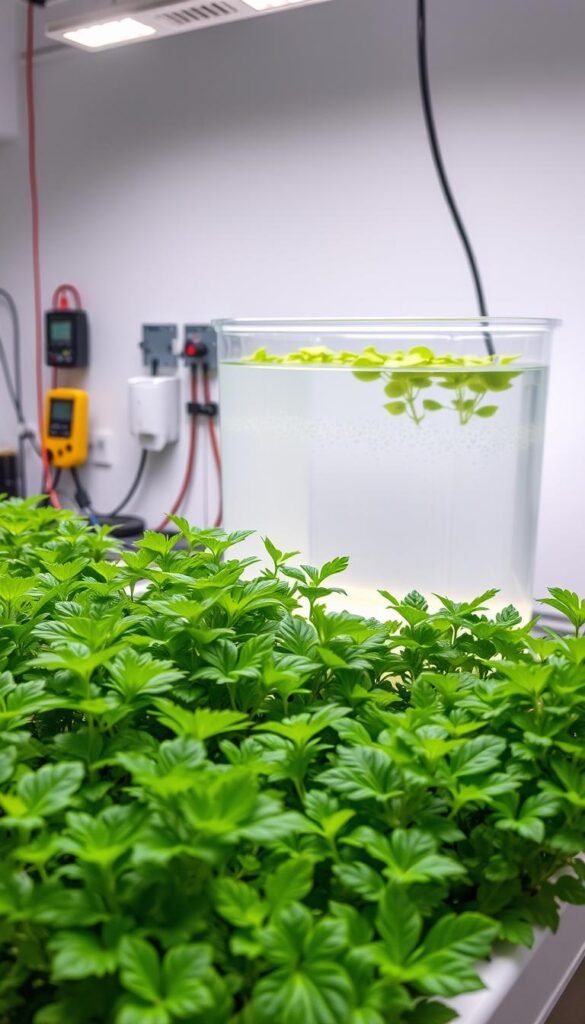
Urban growers and commercial farms alike appreciate the plug-and-play convenience. No juggling multiple bottles or complex calculations. Just dissolve the powder in water, and you’ve got a balanced meal for leafy greens like lettuce.
Advantages of a Single Fertilizer System
These formulas shine in small-scale setups and fast-growing crops. Lettuce producers report 15% faster maturation times using complete blends, according to Colorado State University trials. You’ll need fewer storage containers and avoid compatibility issues between separate nutrients.
Key benefits include:
- Streamlined mixing process (5 minutes vs. 30+ minutes for custom blends)
- Reduced risk of measurement errors
- Consistent macronutrient ratios for predictable growth
But there’s a catch. Some blends skimp on calcium and magnesium – elements crucial for plant structure. A Boston indoor farm discovered their lettuce developed tip burn until they supplemented their complete formula with cal-mag additives.
“Single-source fertilizers cut our labor costs by 40%, but we still test leaf tissue weekly to catch deficiencies early.”
For crops like basil or kale that demand high nitrogen, these all-in-ones work beautifully. Yet fruiting plants like tomatoes often need tailored adjustments during flowering phases. Match the system to your plants’ needs – simplicity versus precision.
How to Choose the Right Fertilizers for Your Hydroponic Setup
Selecting fertilizers isn’t just about what’s in the bottle—it’s about matching your setup’s needs. Three factors dominate this decision: how well ingredients dissolve, your budget, and what’s actually available locally. Get these right, and your plants will show their gratitude through vigorous growth.
Solubility: The Make-or-Break Factor
Water-soluble formulas prevent clogs in pumps and drippers. Greenhouse-grade options dissolve completely, leaving no residue. Cheap fertilizers might save money upfront but often contain fillers that gunk up your system. A Florida strawberry farm learned this the hard way when their $50 fertilizer damaged $2,000 worth of equipment.
| Fertilizer Type | Solubility | Cost per Gallon | Best For |
|---|---|---|---|
| Nitrate-based | High | $0.18 | Leafy greens |
| Ammonium-based | Medium | $0.12 | Acid-loving plants |
| Greenhouse-grade | Ultra-high | $0.25 | All systems |
Cost vs. Availability Tradeoffs
Bulk purchases cut costs but require storage space. Local suppliers might not stock specialized blends—plan ahead during growing season. Online retailers offer wider selection but charge shipping for heavy liquids.
Nitrate formulas work best for fast-growing crops like lettuce, while ammonium options suit blueberries in acidic setups. Test your water quality first—high calcium levels might let you skip supplemental additives. Your plants’ needs and your system’s design should guide every purchase.
Fertilizer Compatibility and Nutrient Interactions
Mixing nutrients in hydroponics is like chemistry class meets farming—get it wrong, and your plants will protest. Some elements clash when combined, creating cloudy solutions or gritty sediments that clog pumps and starve roots. Keeping your liquid diet compatible ensures every drop reaches your crops as intended.
Managing Precipitation and Stock Separation
Calcium and phosphate are the oil and water of hydroponics. Combine them in one tank, and they’ll form insoluble crystals that settle at the bottom. Hydro-Gardens solves this by splitting their stock solutions—calcium nitrate stays separate from potassium phosphate until feeding time. Smart growers use two or three reservoirs to keep reactive ingredients apart.
Tomatoes show the first signs of trouble. Their lower leaves develop brown spots when calcium gets locked out by phosphate reactions. A commercial greenhouse in California lost 15% of their crop before switching to dual-tank systems. Now they premix calcium-rich Solution A and phosphate-heavy Solution B, combining them only in the main reservoir.
Three rules for harmony:
- Never store sulfur and calcium together
- Keep iron chelates away from high-pH solutions
- Use citric acid to stabilize mixes prone to separation
Your plants’ leaf health depends on this balancing act. Check reservoirs weekly for white residues or color changes—these signal brewing conflicts. Clear solutions mean happy roots and robust growth from stem to fruit.
Maintaining Optimal Nutrient Concentrations
Keeping your plants well-fed requires more than just mixing powders in water—it’s about precision delivery. Stock solutions act like concentrated fuel tanks, letting you dose exact amounts through injector systems. This approach prevents sudden spikes or drops in mineral levels that stress roots.
Using Stock Solutions and Injector Systems
Pre-mixed concentrates simplify daily feeding. A dual-tank setup separates calcium from sulfates to avoid chemical reactions. Injectors automatically blend these stocks into your main reservoir, maintaining steady potassium levels crucial for fruit development. Commercial growers report 25% fewer deficiencies using this method.
Monitoring and Adjusting Nutrient Levels
Test daily with calibrated meters—pH swings above 6.5 lock out iron, while EC drops signal hungry plants. One California basil farm adjusts their formula hourly during heatwaves. “Rising temperatures increase evaporation, which concentrates minerals,” explains their head grower. “We dilute the mix to prevent salt buildup.”
Three factors impact stability:
- Water temperature above 75°F speeds nutrient breakdown
- Low solubility formulas leave chalky residues
- Organic additives can cloud solutions over time
Keep detailed logs of adjustments. Notice leaf tips browning? Your potassium might be crowding out calcium. Flush systems monthly to reset mineral balances—your plants will reward you with vibrant growth in all conditions.
Understanding Macronutrients and Micronutrients
Plants thrive on a precise cocktail of elements—get the mix wrong, and your harvest pays the price. Your hydroponic system’s success hinges on balancing two nutrient categories: the heavy hitters plants devour in large quantities, and the tiny helpers that make everything work smoothly.
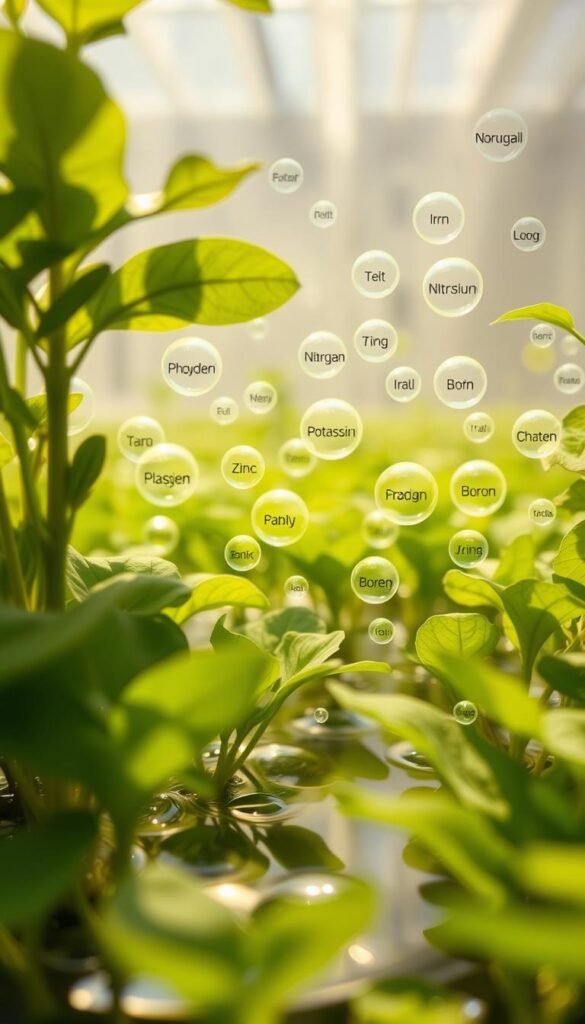
The Role of NPK in Plant Growth
Nitrogen acts like a leafy green factory manager. It fuels chlorophyll production, turning seedlings into bushy plants. Without enough, older leaves yellow while new growth stalls. Phosphorus handles energy transfers and root development—tomato seedlings with weak roots often lack this element.
Potassium keeps plants stress-resistant. It regulates water flow and strengthens cell walls. Crops grown with low potassium wilt faster during heatwaves and bruise easily during harvest.
Importance of Trace Elements
Iron and zinc work behind the scenes. They activate enzymes that convert nutrients into usable forms. A University of Florida study showed adding 0.5 ppm of iron increased basil yields by 19% in raft systems.
Watch for these deficiency signs:
- Purple stems = phosphorus shortage
- Curled leaf edges = calcium deficiency
- Yellow veins = iron locked out
| Nutrient Type | Key Players | Primary Role |
|---|---|---|
| Macro | N-P-K | Structural growth |
| Micro | Fe, Zn, Mn | Enzyme activation |
“Micronutrients are the spark plugs of plant metabolism—without them, the engine sputters.”
Supplement wisely. Use chelated iron for better absorption in high-pH systems. For calcium issues, foliar sprays deliver quick fixes without altering reservoir chemistry. Test your solution weekly—your plants’ roots will show gratitude through vigorous development.
Water Quality, pH, and Other Essential Considerations
The foundation of every thriving hydroponic garden flows from your water source. What you pour into the reservoir determines whether plants feast or famine. Impurities like chlorine or heavy metals can lock out essential minerals, while unbalanced pH levels turn nutrients into inaccessible forms.
Adjusting pH and Preventing Contaminants
Your plants absorb nitrogen best when pH stays between 5.8 and 6.3. Stray outside this range, and up to 40% of nutrients become unavailable. Use digital meters daily—paper test strips lack the precision needed for sensitive crops like lettuce.
Correct imbalances with:
- Food-grade phosphoric acid to lower pH
- Potassium hydroxide to raise alkalinity
- Citric acid for organic systems
Contaminants lurk in tap water and rainwater alike. Chlorine kills beneficial microbes, while excess calcium hardens pipes. A Texas basil farm solved leaf curling by switching to reverse osmosis filtration, reducing dissolved solids from 300 ppm to 30 ppm.
Three safeguards for clean water:
- Install sediment filters before nutrient mixing
- Flush systems monthly to prevent salt buildup
- Test for heavy metals annually
Watch plants for early warnings. Yellowing between veins often signals iron deficiency caused by high pH. Adjustments made within 24 hours can reverse damage before it impacts yields. Your attention to water chemistry keeps roots healthy and harvests abundant.
Using Electrical Conductivity (EC) to Optimize Nutrient Uptake
Your plants’ performance depends on how well they absorb minerals from their liquid diet. Electrical conductivity (EC) measures dissolved salts in water, acting like a nutritional speedometer. This number tells you if your greens are feasting or fasting.
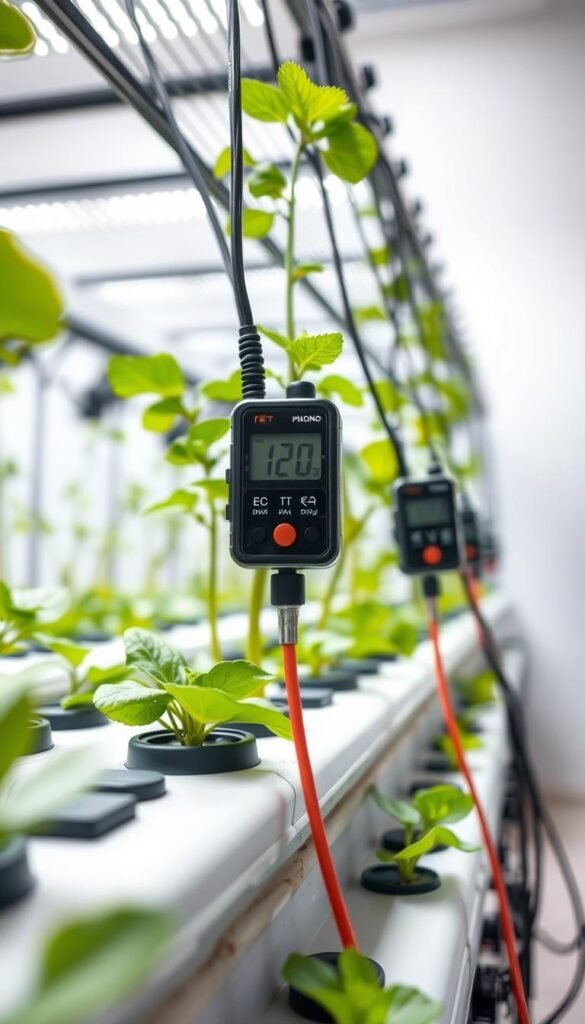
How to Measure and Adjust EC
Use a digital meter to check your solution’s EC daily. Ideal ranges vary by plant type—lettuce thrives at 1.2–1.8 mS/cm, while tomatoes need 2.0–2.5. High readings mean excess salts; low numbers signal hungry roots.
Three factors sway your measurements:
- Water temperature changes conductivity
- Evaporation concentrates minerals over time
- Root health impacts absorption rates
Adjust levels by adding fresh water to dilute strong mixes or boosting nutrients in weak solutions. A Texas tomato farm increased yields by 18% after maintaining EC at 2.3 mS/cm during fruiting. Their secret? Weekly reservoir flushes to reset salt buildup.
| Crop Type | Optimal EC Range (mS/cm) | Critical Threshold |
|---|---|---|
| Leafy Greens | 1.2–1.8 | Above 2.0 causes tip burn |
| Herbs | 1.4–2.0 | Below 1.0 stunts growth |
| Fruiting Plants | 2.0–3.5 | Over 3.8 triggers wilting |
Food quality directly links to EC management. Basil grown at precise levels develops 23% more essential oils, according to a Purdue University study. Keep your meter calibrated and records detailed—your plants’ vigor depends on this invisible balance.
Practical Tips for Mixing and Maintaining Nutrient Solutions
Keep your liquid plant food working smoothly with smart mixing habits. Even distribution ensures every root gets equal access to minerals, while proper upkeep prevents clogs and chemical imbalances.
Agitation and Filtration Techniques
Stirring manually works for small systems, but circulating pumps create consistent motion. Air stones double as oxygen boosters and mixers—ideal for deep water culture setups. These methods prevent micronutrients from settling into “dead zones” where roots can’t reach them.
Filtration plays a critical role in system longevity. Mesh screens (100–200 microns) catch undissolved particles before they block drip emitters. For organic additives, use sediment filters to remove debris that promotes algae growth.
Follow these steps for stable solutions:
- Mix dry nutrients separately before combining
- Run pumps for 15 minutes after adding new elements
- Check filters weekly during peak growth phases
- Flush lines monthly with hydrogen peroxide solution
Light exposure degrades iron and manganese over time. Use opaque reservoirs or cover clear tubing with foil. Water temperature below 75°F helps maintain micronutrient stability—chillers work better than ice packs for large systems.
Track changes with a logbook. Note cloudiness after adding calcium or pH shifts following filtration. Your attention to these details ensures each plant receives the full role of every mineral in their customized diet.
Scaling Nutrient Solutions for Different Hydroponic Systems
Expanding your setup doesn’t require reinventing the wheel—just smarter math. As you move from countertop gardens to commercial operations, phosphorus ratios and solution volumes need careful recalibration. What works for 10 plants might starve 100 or drown 1,000.
Start by calculating your base formula per gallon, then multiply by total water volume. A lettuce farm in Oregon doubled their system size but kept the same 3:1 nitrogen-to-phosphorus ratio. Result? 18% faster growth without nutrient burn. Their secret: incremental adjustments every 48 hours during expansion.
Three scaling strategies prevent imbalances:
- Use circulation pumps to maintain even mineral distribution
- Test phosphorus uptake rates weekly with EC meters
- Divide large reservoirs into zones for targeted feeding
| System Size | Water Volume | Phosphorus Adjustment | Mixing Frequency |
|---|---|---|---|
| Small (1-20 plants) | 5-10 gallons | +0% | Every 7 days |
| Medium (50-100 plants) | 25-50 gallons | +15% | Every 3 days |
| Large (200+ plants) | 100+ gallons | +25% | Daily |
Homemade systems often struggle with sediment buildup. A vertical farm in Nevada solved this by installing inline filters and increasing agitation time by 40%. Their kale now absorbs phosphorus 30% more efficiently, proving consistency beats quantity every time.
Remember: scaling isn’t just about volume—it’s about precision. Double-check concentrations after each adjustment, and your plants will never know the difference between a bucket and a warehouse.
Advanced Strategies for Hydroponic Nutrient Management
Tailoring plant nutrition isn’t one-size-fits-all—it’s a science of precision adjustments. Your crops’ needs shift with their life cycle and surroundings, demanding dynamic responses. Like a chef tweaking recipes for seasonal ingredients, you’ll refine formulas based on real-time feedback from leaves and roots.
Customizing Solutions for Crop-Specific Needs
Plants speak through their growth patterns. Lettuce craves higher nitrogen during leaf development but needs boosted potassium as temperatures rise. Tomatoes demand extra zinc during flowering—a 0.3 ppm increase can improve fruit set by 12%, according to recent studies.
Temperature swings change the game. Warm roots absorb minerals faster, requiring 15-20% weaker solutions to prevent burn. Cooler environments (below 68°F) slow uptake, letting you concentrate mixes without risk. Track daily highs and lows—your plants’ appetites depend on it.
| Crop | Growth Stage | Key Adjustments |
|---|---|---|
| Basil | Vegetative | +20% iron, 72°F max |
| Strawberries | Fruiting | +0.5 ppm zinc, pH 5.8 |
| Kale | Seedling | Reduce EC by 30% |
Zinc plays multiple roles—it activates enzymes and strengthens cell walls. Deficiency shows as twisted new leaves, while excess locks out copper. Test every growth stage: seedlings need 0.1 ppm, flowering plants 0.4 ppm. Pair with manganese for photosynthesis boosts.
Your strategy evolves with each harvest. A vertical farm in Arizona increased yields by cycling three formulas daily based on temperature spikes. Their secret? Automated dosing systems that adjust micronutrients every six hours. Start small—track one variable like zinc levels—then expand your toolkit as confidence grows.
Conclusion
Your hydroponic system’s success hinges on one critical choice: the liquid diet you serve your plants. Whether you choose pre-made blends for convenience or craft custom recipes for precision, iron availability remains a cornerstone of healthy growth. Leafy greens demand accessible iron for chlorophyll production, while fruiting crops need steady supplies to prevent yellowing veins.
Balanced formulas work best when paired with regular testing. Simple EC meters and pH pens help maintain optimal mineral availability, especially during temperature swings. Remember – roots absorb nutrients 3x faster in hydroponics than soil, making consistency your top priority.
From commercial fertilizer programs to DIY mixes, each approach offers unique advantages. Pre-mixed solutions save time, while tailored recipes let you address specific deficiencies like iron shortages. Pair these strategies with weekly reservoir checks and proper agitation for maximum nutrient uptake.
As you refine your system, prioritize solutions with proven iron availability and compatible mineral ratios. Your plants will reward careful planning with vibrant leaves, sturdy stems, and harvests that make dirt gardening seem primitive. Now go mix confidence into every gallon!
